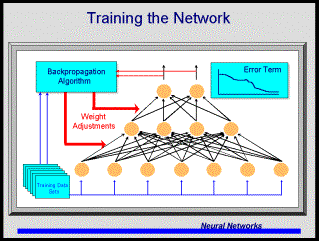
Basic
Material, Applications,
and Vendors
TutorialApplicationshttp://www.iiit.net/~vikram/nn_intro.html
Everyday demos
http://www.imagination-engines.com/usefulne.htm
Light descriptions of neural networks
http://zsolutions.com/light.htm
History and principles
http://neurocomputing.org/history.htm
Good discussion
http://www.neusciences.com/nn_intro.htm
Non-linear black box modeling techniques ]
http://www.ncl.ac.uk/cpact/neural_networks_nf.html [
More detailed neural networks tutorial
Motion Vision and Sensor Fusion; with training and support services.
http://www.navysbir.brtrc.com/SuccessStories/lnk.htmlNeural Networks Based Fault Diagnosis for the NASP
http://www.accurate-aviation.com/contracts/airforce.htm
Neural Network Applications from Japan Singapore Artificial Intelligence Centre (JSAIC):
http://jsaic.krdl.org.sg/tralvex/pub/nap/
Discussion of Experiences/Applications of Neural Networks by Sandia lab:
http://reliability.sandia.gov/Industrial_Engr/Neural_Network_Analysis/neural_network_analysis.html
Image & Nonlinear Signal Processing
http://www.causalproductions.com/TEMP/INDEX/IC99S212.HTM
Georgia Tech Vision (GTV) Neural Network model funded by Army and Air Force:
http://www.ece.gatech.edu/research/labs/NeuralNets/research.html
FAA Loop Technology (LOT) as an Alternative Surface Surveillance System:
http://www.faa.gov/faa_office/rirp/RIRP_Article/DASC_Final.htm
Detection and Tracking of Moving Targets
http://jsaic.krdl.org.sg/tralvex/pub/nap
The moving target detection and track methods here are "track before detect" methods. They correlate sensor data versus time and location, based on the nature of actual tracks. The track statistics are "learned" based on artificial neural network (ANN) training with prior real or simulated data.
Multi-Sensor Data Fusion for Helicopter Guidance
http://www.ecs.soton.ac.uk/publications/rj/1995-1996/isis/rsd/research.htm
Helicopter crews are required to carry out a wide range of duties most of which involve operational safety. One particular flight safety problem that has relevance to a variety of different types of rotorcraft is assisting the pilot in obstacle avoidance.. Since the dynamics of the obstacles may not be be linear, the process models must be capable of reflecting non-linear behaviour. The uncertain information produced by the various sensors will be related to required knowledge about the obstacles by a sensor model, however this relationship need not be linear, and may even have to be learnt. The information sources of interest may be distributed over many platforms, therefore the architecture of the data fusion system must reflect the spatially distributed nature of the problem.
Neural Analysis of Russian Banks Balance Sheets
http://canopus.lpi.msk.su/neurolab/
It is not an easy task to visualize the state of the whole banking system. In Russia it comprises about 2000 banks each having a balance with about 30 parameters. We use the technique of neural principal components analysis to reduce the input space dimensionality and then apply self-organazing feature maps to construct a 2D Kohonen map of Russian banks. Different balance items give rise to different colorings on that map. Thus one obtains a Kohonen atlas of Russian banking system as a usefull visualization tool for financial analysis.
Modeling Laser Welding Processes by Analysis of Optical Emissions
http://www-xdiv.lanl.gov/XCM/control/welding/mosaic_weld.html
The Adaptive Computation section of X-1 at LANL currently has a DOE/DP Small Business Initiative project with the Laser Institute of America for laser weld monitoring. We are collaborating with a number of researchers in the MTL and CST divisions at LANL. Our short-term goal is to infer weld quality from spectroscopic measurements. This will replace the time consuming and destructive methods of weld verification currently in use. Our long-term goal is to perform adaptive control and fault management for laser material processing. The benefits of adaptive control for laser welding are that it is capable of tracking drifts in the system (e.g., aging of the welder or changes in the parts being welded), and it does not rely on a first-principles model.
Engine Management
http://www-xdiv.lanl.gov/XCM/neural/xwindows/enginecrada.html
Los Alamos, Non-Linear Adaptive Computation, X-Division is expanding its application of neural networks in the auto industry. Under a new Engine-Management CRADA, researchers are investigating the use of neural networks to identify optimum fueling for engines during accelerations and decelerations, and to adaptively control fueling as the engine ages and as fuel properties change. DOE has given LANL $2.4M to work with industrial partners General Motors, Ford, and Chrysler (the American automotive Big-3) to help them meet the coming more stringent emission levels for automobiles.
Other Examples
http://www.icv.ac.il/DataBases/biblio/rosenfeld/kwic/neu.html
NeuroDimension, Inc: The World Leader in Neural Network SoftwareCompiled by the Intelligent Decision Systems Course Team June 27, 2000; John Saunders, facultyCalifornia Scientific Software / BrainMaker Neural Network Software
Pattern Recognition Software for e.g. gene expression & microarray analysis
Attrasoft Neural Network Application Software
BackPack Neural Network System
http://www.zsolutions.com/pathfind.htm
NeuroShell 2 Neural Network Software Home
http://www.wardsystems.com/neuroshe.htm
Neunet Pro - Neural Network Software
http://www.cormactech.com/neunet/index.html
THINKS and ThinksPro: Personal and Professional Neural Network
http://www.sigma-research.com/bookshelf/rtthinks.htm
Neuro predictor
http://www.technimode.com/neuropredictor/main.htm
NeuroGenetic Optimizer™, (NGO)
Team Members: Betty Bensel, Martha Cain, Elizabeth Johnson, Inara Kuck, Mary McCully, Bob Payne, Peter Proko, Joe Spegele, Nicole Stermer, Craig Vance, and Dan Vitiello